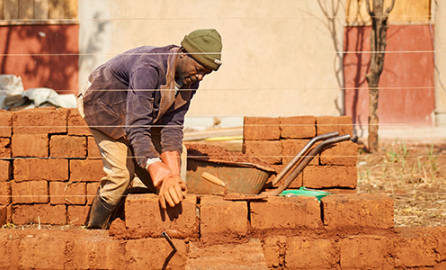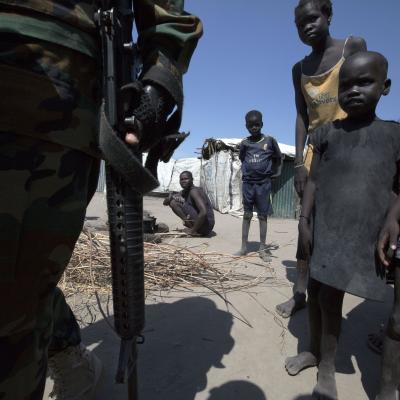There was a question posed more than once at this year’s European Development Days in Brussels. Most participants agreed the concept of “resilience” has been widely embraced since a 2012 EU communication on the topic, but many still asked, “resilient to what?”
“Situations are very diverse between countries, even inside of countries, between regions, ethnicity, and cultures” said Maria-Manuela Cabral, Head of Unit for Resilience, Fragility at the European Commission’s cooperation and development arm, DEVCO. In some contexts, a community at risk of drought may soon face a flood, for example.
Cabral added, “there is probably no better moment when countries, communities and societies understand what resilience might mean than in a crisis situation.”
She gave the example of Nepal: “They have completely changed their internal structure from a central government into a federal government to be closer to the local communities outside Kathmandu which were the most touched by the [April 2015] earthquake.”
The nexus between humanitarian interventions and development work remains at the heart of a new joint communication on ‘A Strategic Approach to Resilience in the EU’s External Action’. This document expands the 2012 notion of resilience – "the ability of an individual, a household, a community, a country or a region to withstand, adapt and quickly recover from stresses and shocks" – to place more emphasis on the role of states.
“The debate on resilience is not an institutional debate, but it’s a debate with the countries themselves,” said Cabral, adding that development partners must “take ownership about what their problems are and what are the most probable risks they may face.”
The EU is changing its approach too.
Roger Bellers, a policy officer at the Commission’s humanitarian arm, ECHO, recalled that in 2015 his department introduced a resilience marker on its projects. This asks not only whether the assistance helped, but also “Do we understand the causal reasons of vulnerability? And, can we work with partners to do something about it?”
“Where we can we are working through local systems, rather than setting up parallel humanitarian systems,” he said, citing the case of northern Nigeria where there now exist early-response systems to signal influxes of displaced people.
For Bellers, asking “resilient to what?” is often unnecessary.
“If you have a low coping capacity – whatever the causes of that are – it doesn’t matter what the shock is,” he told a panel at the EDDs in June. “In many situations we know who are vulnerable and what they are vulnerable to. We also know people who are less able to adapt to shocks and that’s where I think we need to be far more deliberate in taking action.”
|
Jo Scheuer is the Director of the Climate Change and Disaster Risk Reduction Cluster in the UNDP’s Bureau for Policy and Programme Support in New York. In the following video he discusses key issues related to disaster recovery and particularly the need for sustained financial mechanisms for recovery [start], opportunities to engage the private sector in recovery efforts [01:29], the importance of targeting the right beneficiaries through recovery interventions not to leave anyone behind and why the need for disaster preparedness is now more widely accepted [04:13] |
In some cases, the elasticity of resilience is also a virtue.
Virginie Le Masson, a research fellow on social development, risk and resilience at the Overseas Development Institute, argued that precisely because “nobody knows what it means exactly,” using the resilience concept may be a useful way for development practitioners to begin sensitive conversations.
Often, inequalities in societies need to be tackled in order to build resilience. Otherwise, those who are excluded remain vulnerable to disasters and climate change.
So when we frame the discussion around enhancing the resilience of communities, “it’s possible to slowly integrate issues that are sensitive such as violence against women, inequalities at the household or community level, unsustainable livelihoods, and so on,” said Le Masson.
Rabiya Mukhtar, a disaster risk management specialist at the Provincial Disaster Management Authority in Punjab province, Pakistan, has faced similar challenges.
Some of the key questions she and her colleagues seek to answer when working on disaster preparedness is, “Who has the power within the family, to make decisions, to do what, and when?”
In order to win residents’ trust, Mukhtar said, her team uses female surveyors to enquire about sensitive topics, and ensures those asking the questions speak the local language.
She conceded however that some topics – such as who is pregnant and whether there have been any cases of sexual violence following natural disasters – remain taboo.
When shocks do occur, Hiba Qasas, chief of crisis prevention, preparedness and response at UN WOMEN, pointed out that “risk is not equally shared.”
More than 90% of those who died in the 1991 cyclone in Bangladesh were women and children, Qasas said, pointing out that the pattern repeated in the 2004 Aceh tsunami, when women and children accounted for 77% of fatalities.
Qasas suggested another possible governance solution: A quota for women on disaster management bodies.
“Yes there will be some token women – as there are token men by the way – but we would be allowing women to engage and inform,” Qasas said. “Women have an intimate knowledge of the needs of their community but they bring a different perspective.”
Banner image : European Union + Will Boase







Comments
Log in with your EU Login account to post or comment on the platform.